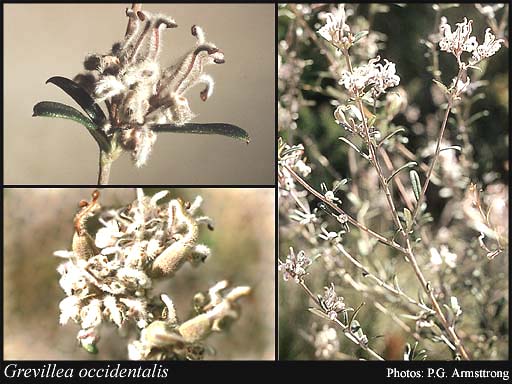- Reference
- Trans.Linn.Soc.London 10:173 (1810)
- Conservation Code
- Not threatened
- Naturalised Status
- Native to Western Australia
- Name Status
- Current
Spreading to erect shrub, 0.4-1(-1.8) m high. Fl. pink-white-other, May to Jul or Sep to Dec or Jan to Feb. Sand over laterite or granite, gravel, loam.

Scientific Description
Shrubs, 1-1.5 m high; branchlets hairy, not glaucous. Leaves alternate, 10-45 mm long, 2-8 mm wide, hairy or glabrous, on the abaxial surface, the hairs straight; lamina flat, clearly widest above the middle, entire, the margins recurved or revolute, exposing the lower surface of the leaf blade. Inflorescences axillary or terminal, white or grey; pedicels 4-7 mm long. Perianth 3-5 mm long; tepals some joined and some free after flower opens, hairy, simple-hairy; ovary hairy, stipitate, the stipe 0.5-1 mm long; pistil 6-9 mm long, pink, pollen presenter lateral or oblique, style hairy. Follicles hairy, not viscid, dehiscent, 8-11 mm long. Flowers in January, February, August, September, October, November or December. Occurs in the South-west (SW) Botanical Province(s), in the Avon Wheatbelt (AW), Jarrah Forest (JF), Warren (WAR) or Esperance Plains (ESP) IBRA subregion(s).
Distribution
- IBRA Regions
- Avon Wheatbelt, Esperance Plains, Jarrah Forest, Warren.
- IBRA Subregions
- Fitzgerald, Katanning, Southern Jarrah Forest, Warren.
- IMCRA Regions
- WA South Coast.
- Local Government Areas (LGAs)
- Albany, Cranbrook, Denmark, Manjimup, Nannup, Plantagenet.